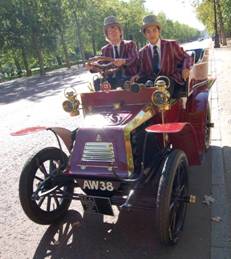
At the dawn of motoring a number of different avenues were pursued by Victorian inventors for powering the motor car. In the end the petrol internal combustion engine became the preferred method of power and the rest as they say is history. However the London to Brighton Veteran Car Run (LBVCR) has eighteen examples of steam and electric powered vehicles, all of which are at least 102-years-old.
Electric Power
The three electric vehicles are fully working examples of a method of power that is starting to become popular again in the 21st century with the advent of hybrid technology and the concerns of global warming.
Mr. Reginald Blennerhassett-Plunkett from Dublin drives the oldest electric powered vehicle on the London to Brighton Veteran Car Run, a 1900 Cleveland Stanhope capable of a top speed of 15mph. The car is a firm favourite with the public and won the ‘Public’s Choice’ award at the 2005 Regent Street Concours.
The second electric vehicle is owned by Mr. John Hanson from Michigan in the United States drives a 1902 Columbia Tonneau. This will be John’s 34th LBVCR event in this car, which has only failed to reach the finish on one occasion.
The youngest electric car on the 2006 Run is a 1903 Waverley Surrey (pictured above) that was previously owned by the Edison Institute Museum and is now the pride and joy of Mr. Gervase Forster from Little Chalfont in Buckinghamshire. Aptly nicknamed ‘Sparky’ the Waverley is capable of 30mph and can travel 50 miles before needing a recharge. This means that the support crew need to ‘refuel’ using jump batteries at Crawley before the car can complete the 60-mile journey to Brighton.
Under their own Steam
The fifteen examples of steam powered vehicles on the 2006 LBVCR are a good cross section of the drive to perfect steam as a viable alternative to the petrol car at the turn of the 20th Century.
The oldest steam car is the 1896 Salveson Open Cart owned by John Brydon from Nottinghamshire. It is one of the most primitive vehicles on the Run and the crew will arrive in Brighton with black faces from shoveling coal into the small furnace to keep the car moving at an average 12mph. Brian Kenway from Hook in Hampshire owns an 1896 Whitney Runabout, which is more comfortable than the Salveson and has a top speed of 30mph.
On the 2006 Run there are three examples of the Stanley Steamer and a Stanley still holds the world landspeed record for a steam car, set by Fred Marriot in 1906 with speed of 127.659mph. Charles Burnett III from Lymington in Hampshire is leading an all British team to try a new attempt on this record but will be driving this Sunday at a more sedate 18mph, the cruising speed for his steam driven1903 Stanley Runabout.
Other Steam Powered entries:
Mr. Loic de L’Arbre – Beersel, Belgium – 1901 Steamobile Two Seater
Tim Watson – Hailsham, East Sussex – 1901 Toledo Runabout
Peter Williams – Chipperfield, Hertfordshire – 1904 Stanley Stanhope
Peter Lumsden – Dover, Kent – 1899 Locomobile Spindle Seat Runabout
Robert Dale – Market Rasen, Lincolnshire – Gardner-Serpollet Double Phaeton
Mrs Kerrie Curry – Southall, Middlesex – 1902 Locomobile Spindle Seat Runabout
Timothy Senior – Hitchen, North Yorkshire – 1902 Toledo Dos-a-dos
Robert Ward – Bury St Edmunds, Suffolk – 1901 Locomobile Spindle Seat Runabout
Robert Ward – Bury St Edmunds, Suffolk – 1903 Stanley Runabout
John Blackford – Calne, Wiltshire – 1900 Mobile Runabout
Richard Hounslow – Salisbury, Wiltshire – 1900 Mobile Spindle-seat Runabout
Arthur Thomson – Salisbury, Wiltshire – 1904 White Tonneau